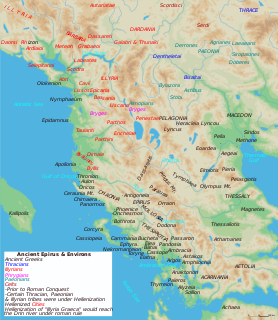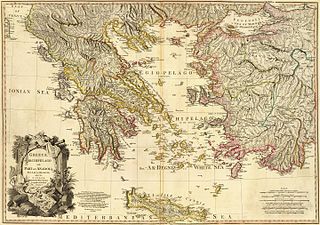 W
WAbsyrtus was a Greek veterinary surgeon.
 W
WThe Macedonians were an ancient tribe that lived on the alluvial plain around the rivers Haliacmon and lower Axios in the northeastern part of mainland Greece. Essentially an ancient Greek people, they gradually expanded from their homeland along the Haliacmon valley on the northern edge of the Greek world, absorbing or driving out neighbouring non-Greek tribes, primarily Thracian and Illyrian. They spoke Ancient Macedonian, which was either a sibling language to Ancient Greek or a Doric Greek dialect, although the prestige language of the region was at first Attic and then Koine Greek. Their religious beliefs mirrored those of other Greeks, following the main deities of the Greek pantheon, although the Macedonians continued Archaic burial practices that had ceased in other parts of Greece after the 6th century BC. Aside from the monarchy, the core of Macedonian society was its nobility. Similar to the aristocracy of neighboring Thessaly, their wealth was largely built on herding horses and cattle.
 W
WCappadocian Greeks also known as Greek Cappadocians or simply Cappadocians are an ethnic Greek community native to the geographical region of Cappadocia in central-eastern Anatolia, roughly the Nevşehir Province and surrounding provinces of modern Turkey. There had been a continuous Greek presence in Cappadocia since antiquity, and the indigenous populations of Cappadocia, some of whose Indo-European languages may have been closely related to Greek, became entirely Greek-speaking by at least the 5th century. In the 11th century Seljuq Turks arriving from Central Asia conquered the region, beginning its gradual shift in language and religion. According to 1897 estimations, the sanjak of Konya had a total Greek population of 68.101 and according to Ottoman population statistics of 1914, the sanjak of Niğde had a total Greek population of 58.312 and the sanjak of Kayseri had a total of 26.590. In 1923 following the genocide of the minorities of Turkey the surviving Cappadocian Greek native communities were forced to leave their homeland and resettle in modern Greece by the terms of the Greek–Turkish population exchange. Today their descendants can be found throughout Greece and the Greek diaspora worldwide.
 W
WTitus Flavius Clemens, also known as Clement of Alexandria, was a Christian theologian and philosopher who taught at the Catechetical School of Alexandria. Among his pupils were Origen and Alexander of Jerusalem. A convert to Christianity, he was an educated man who was familiar with classical Greek philosophy and literature. As his three major works demonstrate, Clement was influenced by Hellenistic philosophy to a greater extent than any other Christian thinker of his time, and in particular, by Plato and the Stoics. His secret works, which exist only in fragments, suggest that he was familiar with pre-Christian Jewish esotericism and Gnosticism as well. In one of his works he argued that Greek philosophy had its origin among non-Greeks, claiming that both Plato and Pythagoras were taught by Egyptian scholars.
 W
WThe Dassaretae, or Dexaroi, were an ancient Greek tribe of Epirus living from Mount Amyron to Lake Lychnitis on the border with Illyria. They were the northernmost tribe that belonged to the Chaonian group, one of the three major tribes in Epirus. In Roman antiquity their territory was considered as part of Upper Macedonia.
 W
WThe Dorians were one of the four major ethnic groups into which the Hellenes of Classical Greece divided themselves. They are almost always referred to as just "the Dorians", as they are called in the earliest literary mention of them in the Odyssey, where they already can be found inhabiting the island of Crete.
 W
WThe Gelonians, also known as Helonians, are mentioned as a nation in northwestern Scythia by Herodotus. Herodotus states that they were originally Hellenes who settled among the Budinoi, and that they are bilingual in Greek and the Scythian language.
 W
WPhye was a young woman from Paeania who accompanied the tyrant Peisistratos in a chariot during his return to Athens in 546/5 BCE. Phye was dressed as the goddess Athena in order to deceive the people of Athens into believing that Peisistratos' return to Athens was divinely sanctioned.